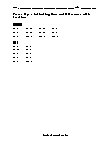Estimating Sums and Differences (Fractions) Worksheets
How Do You Estimate Sums and Difference Between Fractions? Estimation is one of the valuable skills and is commonly used in our daily lives. Doing the estimation of whole numbers and integers is much easier than performing the same at fractions. We can estimate, add or subtract numbers like 4, 12, 344 quickly, but estimating numbers like 4/5 or 9/11 poses a challenge for us. Understanding how to perform addition and subtraction on fractions can save us time and also get us the approximate answer. To ease your estimation, remember the tip for rounding off the fraction to their nearest 1/2. As per this rule, the fractions would be rounded off to 0, 1/2, or 1. Any fraction with a value less than 1/4 will be rounded off to 0. Fractions that are equal to or greater than 1/4 and less than or equal to 3/4 will be rounded off to 1/2. Every fraction with a value greater than 3/4 will be rounded off to 1. You can also solve the problem without converting them to their nearest ½ values. For instance, you are given the fraction 9/16 and 5/12. First, you would convert each fraction to achieve the same denominators. 9/16 would be converted into 27/48, and 5/12 would be converted into 20/48. Then add or subtract both the values 27/48 + 20/ 48 = 47/48. Subtraction is carried out in the same way. 27/48 - 20/48 = 7/48.
-
Basic Lesson
Demonstrates how to estimate sums with fractions through the use of round estimation. Also includes practice problems.
View worksheet -
Intermediate Lesson
Uses a larger more difficult numbers to round than the basic lesson.
View worksheet -
Independent Practice 1
20 problems ask you to estimate sums and differences with fractions. The answers can be found below.
View worksheet -
Independent Practice 2
20 practice problems that review estimating sums and differences with fractions. The answers can be found below.
View worksheet -
Homework Worksheet
12 problems to reinforce the lessons and practice pages. An example is provided.
View worksheet -
Skill Quiz
10 problems that test sum and difference with fractions estimation skills.
View worksheet
Here are some amazing food facts:
there are more than 1,119,421,445 overweight people walking around the earth right now, yet there still remains 887,226,547 undernourished men, women and children throughout the globe.







